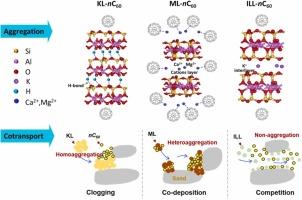富勒烯纳米颗粒与粘土胶体在多孔介质中的共传输:聚集与传输之间的关系
IF 11.3
1区 环境科学与生态学
Q1 ENGINEERING, ENVIRONMENTAL
引用次数: 0
摘要
本研究探讨了富勒烯纳米颗粒(nC60)和流动粘土胶体(伊利石(ILL)、高岭石(KL)和蒙脱石(ML))在含水层多孔介质中的共迁移及其与这两种颗粒之间聚集相互作用的关系。nC60 与 ILL 之间的相互作用极小,因此迁移不受影响。ML 和 nC60 之间的强烈异聚集不仅导致这两种粒子在共传输过程中大量保留,而且还导致 nC60 保留在预先注入 ML 的介质中。KL 的强烈同聚集会产生强烈的应变效应,从而在共传输过程中保留 KL 和 nC60,但在连续注入 KL 和 nC60 的过程中不会保留 nC60。吸附沉积实验、显微镜观察、粒度和 zeta 电位测试以及模型模拟都很好地证明了这种聚集行为。根据表面化学分析,ML 与 nC60 之间的二价阳离子桥和 KL 颗粒之间的氢键分别是异聚集和同聚集的原因。该研究证明了移动粘土和 nC60 之间的聚集与粘土化学的特异性及其对颗粒共迁移的影响,这对于评估 nC60 的环境风险至关重要。本文章由计算机程序翻译,如有差异,请以英文原文为准。

Cotransport of fullerene nanoparticles and clay colloids in porous media: The relation between aggregation and transport
In the study, cotransport of fullerene nanoparticles (nC60) and mobile clay colloids (illite (ILL), kaolinite (KL), montmorillonite (ML)) in aquifer porous media and its relation to the aggregative interaction between these two types of particles was investigated. Minimal interaction occurred between nC60 and ILL, resulting in unaffected transport. Strong heteroaggregation between ML and nC60 resulted in not only significant retention of both particles during their cotransport but also the retention of nC60 in the media pre-injected with ML. Strong homoaggregation of KL caused strong straining effect and consequently retention of both KL and nC60 during their cotransport, however, the pre-emplacement of KL did not cause retention of nC60 during the sequential injection of KL and nC60. Such aggregation behaviors were well demonstrated by the adsorption-sedimentation experiment, microscopic observation, the size and zeta-potential test, and model simulation. Based on the surface chemistry analysis, divalent-cation bridging between ML and nC60 and hydrogen bonding between KL particles were responsible for the heteroaggregation and the homoaggregation, respectively. The study demonstrated the specificity of the aggregation between the mobile clays and nC60 to the chemistry of the clays and its consequent effect on the cotransport of the particles, which is critical for assessment of the environmental risk of nC60.
求助全文
通过发布文献求助,成功后即可免费获取论文全文。
去求助
来源期刊

Journal of Hazardous Materials
工程技术-工程:环境
CiteScore
25.40
自引率
5.90%
发文量
3059
审稿时长
58 days
期刊介绍:
The Journal of Hazardous Materials serves as a global platform for promoting cutting-edge research in the field of Environmental Science and Engineering. Our publication features a wide range of articles, including full-length research papers, review articles, and perspectives, with the aim of enhancing our understanding of the dangers and risks associated with various materials concerning public health and the environment. It is important to note that the term "environmental contaminants" refers specifically to substances that pose hazardous effects through contamination, while excluding those that do not have such impacts on the environment or human health. Moreover, we emphasize the distinction between wastes and hazardous materials in order to provide further clarity on the scope of the journal. We have a keen interest in exploring specific compounds and microbial agents that have adverse effects on the environment.
 求助内容:
求助内容: 应助结果提醒方式:
应助结果提醒方式:


